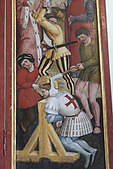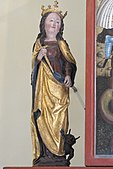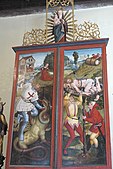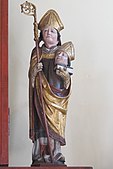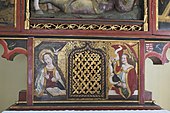George Altar (Milbertshofen)
The George altar in the old church of St. Georg in the former Schwaige Milbertshofen , which today belongs to Munich, is a late Gothic winged altar that is attributed to Jan Polack's circle .
history
The Milbertshofener Altar was donated by Abbot Leonhard II Schmid of the Schäftlarn monastery and was erected there in 1510 as part of the expansion and refurbishment of the Schwaig Church, first mentioned in 1360. The altar was renovated for the first time in 1599. During the Second World War , the altar was moved to the Bavarian National Museum and in the 1980s it was installed in the new Milbertshofen parish church , which was built around 1910 . After a general restoration between 1996 and 2003, the altar was returned to its original location in the old Georgskirche.
construction
The altar consists of a central shrine with a filigree split , a movable pair of wings and a predella . The predella and the two wings are painted, the central shrine is carved. A figure of the Madonna with a child stands in the middle, surrounded by a halo.
iconography
The altar is dedicated to the legend of St. George , as portrayed in the Legenda aurea . St. George is venerated as a martyr and as one of the fourteen helpers in need.
Open state
The open state of the altar is also known as the Sunday or holiday side. In the middle shrine, St. George is depicted as a dragon slayer. He rides a white horse and thrusts his lance into the mouth of a dragon. Two angels hover over his head, holding his helmet. On the right side the king's daughter, who is to be sacrificed to the dragon, kneels next to her a lamb, on the left side you can see her parents on a balcony.
On the left wing you can see St. George, who is tied to a wooden stake with ropes at the gates of a town and who is bloodily beaten by a torturer with an ax. The beheading of St. George is depicted on the right wing. He is dressed in armor on which a large George cross is emblazoned. In the background you can see the city wall reinforced with towers and a city gate.
Closed state
When closed, the working day side of the altar, the figures of St. Juliana of Nicomedia and St. Dionysius of Paris , the patron saints of the Schäftlarn monastery church, appear. The outside of the wings are painted with further scenes of the legend and martyrdom of St. George. On the left, Georg kills the dragon with his sword. In the background, the princess leads her lamb on a leash in front of a mountain landscape, the royal couple is watching the scene on a balcony. On the right hand side, St. George is wheeled and rolled in a barrel studded with nails.
Predella
On the predella is preaching shown. In the middle, between Mary and the Archangel Gabriel , a sacrament niche was subsequently cut. The coats of arms of the Schäftlarn monastery, a boat with two oars, and the abbot Leonhard II. Schmid, the founder of the altar, can be seen on the side.
literature
- Georg Dehio: Handbook of German Art Monuments - Bavaria IV - Munich and Upper Bavaria . 2nd edition, Deutscher Kunstverlag, Munich 2002, ISBN 3-422-03010-7 , p. 695.
- The Milbertshofen St. George altar from 1510 . Catholic Parish St. Georg Milbertshofen (Ed.), Leaflet.
Web links
- Old St. George altar in the Archdiocese of Munich and Freising, Milbertshofen parish association
- Old St. George's Church and the Friends of the Archdiocese of Munich and Freising, Milbertshofen Parish Association
Individual evidence
- ↑ Joachim Schäfer: Heiliger Georg Ökumenisches Heiligenlexikon, accessed on September 22, 2018
Coordinates: 48 ° 11 ′ 14.7 " N , 11 ° 33 ′ 48.4" E




